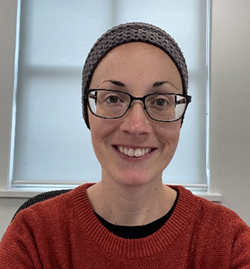Carers Week is an annual campaign to raise awareness of caring, highlighting the challenges carers face and recognising the contribution they make to their families and communities.
We spoke to our colleague Carly Greenwood, Principal Auditor, who shares her story on what it means to be a carer for her daughter with type 1 diabetes.
 Carly’s story
Carly’s story
As a mum, nothing prepares you for the news that your child has a life-long and life-threatening condition.
My daughter was just four years old when she was diagnosed with type 1 diabetes. I didn't know how life-changing a type 1 diabetes diagnosis could be until it happened to my family.
There is no cure, and she requires round-the-clock monitoring and care. I'm thankful we spotted the signs early – you may hear of the 4T's to watch out for (tired, thinner, thirsty, toilet). At the point she was admitted to the hospital, her blood glucose levels were extremely high - but she wasn't in diabetic ketoacidosis, a life-threatening complication that many children suffer from before diagnosis and it’s a risk we have to watch out for daily.
The first few days and weeks were tough, mentally and physically. Overnight, my wife and I had become full-time carers alongside the usual chaos of raising two young children and working full-time, whilst trying to come to terms with our daughter's diagnosis and what this meant for both her and us and our future. Our daughter, as courageous and resilient as she has been, was understandably terrified of this new regime of endless finger pricks and insulin injections. It was heartbreaking to see her in fear, knowing we had to give her every injection to keep her alive.
We're incredibly grateful for the technological developments which make managing diabetes a little bit more bearable. My daughter has a continuous glucose monitor and an insulin pump that replaces upwards of six daily injections to a cannula change every three days. This means we can see her blood glucose readings on our phones, alerting us if her blood glucose levels fall too low or goes too high. Low blood glucose (hypoglycaemia) is extremely dangerous and life threatening if left untreated. These are the most urgent alarms where we must treat her immediately by giving her glucose, even if it means waking her up at night.
The preparation that goes into each day takes up a significant amount of our time. With every meal or snack my daughter eats, we have to meticulously count the carbohydrate value to calculate the correct insulin dose. It's tough to predict how much a five-year-old will eat - if she doesn't eat enough, we have to make sure she makes up the carbs with a different snack. We also often have to split the dose as some foods have a slower release, meaning the impact on blood glucose levels isn't seen until much later.
We're up most nights treating hypos or to give correction doses of insulin. We've compared it to having a newborn - you never know when you will be woken up or for how long. The toll it takes having such broken sleep is probably one of the hardest things I've had to come to terms with since her diagnosis.
Some people ask why her numbers haven't steadied out yet or whether we've got her diabetes under control. I find these questions difficult to answer. There are so many variables which impact blood glucose, and many are impossible to predict or plan for.
There have been times when I've been mid-meeting at work, and I've had to drop everything to get to my daughter. This is my life now - being a carer for a disabled* child is a full-time role, alongside being a mother and having a career. I'm thankful for the understanding I've received at work and the flexibility that M&G provides to deal with these situations. Without it, I'm not sure where I'd be.
M&G’s Carers Policy
We understand that balancing work and significant caring responsibilities can be tough, which is why our UK Carers Policy includes 10 days of paid carers leave alongside our working flexibly policy.
*In the UK, whatever type of diabetes you have, if you need to take insulin or other medication, it is classed as a disability by law.